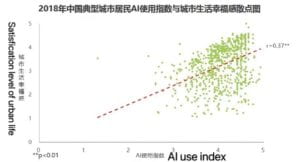Wenjun Fang (wf646)
Smart Cities in the AI Era
In 2018, the first “China’s AI City Perception Index Report” was published by Sense Time and iResearch. From the perspective of citizens’ sensibility, this report aimed to better understand the ideas of the AI city and discover new opportunities and directions on the development of AI urbanism. In fact, intelligent networking led by artificial intelligence is the next step in smart city construction. Introduce artificial intelligence into the urban planning process will have significant influences on “mitigates the operational and social vulnerabilities of an urban system” (Synced, 2020), as well as improve the public’s life satisfaction level.

From the sensibility index report, we can see that AI has already been used in different application scenarios such as governance, education, medical, public transportation, and retails. The research focuses on six main cities in China, which include Beijing, Shanghai, and Shenzhen. Most of these cities’ populations have characteristics that include younger (under 35), better educated, and higher income. They are more familiar with smart city products, also willing to accept new technologies. Therefore, those cities have a high demand for AI-related services under different contexts of use.
The report using Pearson’s correlation analysis to illustrate the results of their research, which showed that the AI use index of citizens in the six cities, which are the typical urban area in China, is positively correlated with the citizens’ happiness in urban life. In other words, the AI index can positively affect residents’ urban life to a certain extent. More frequently, the citizens using AI related services in different scenarios will increase their satisfaction level with the city. AI has penetrated into all aspects of urban residents’ lives, helping residents getting a more convenient and higher quality of life. Enhancing the popularization of AI will also be an important way to improve the happiness of urban residents.

As the importance of ‘people’ in cities is being paid more attention, in addition to providing more systematic and intelligent applications and services, AI city is paying more attention to the ‘user experience’ of these applications and services. At the same time, as the government, industry, and citizens continue to increase the demand for AI, artificial intelligence city planning has more ‘big picture’ thinking. The developing model has changed from top-down to bottom-up. More vendors appeared, offering more detailed and comprehensive solutions to solve the market demand and create or update new contexts of use.
Citation
China’s AI City Perception Index Report, by Sense Time & iResaerch, http://www.iresearchchina.com/content/details8_50083.html
Unknown author, Aug 28th, 2020, Can AI reimagine city configuration and and automate urban planning? Published by SYNCED, https://syncedreview.com/2020/08/28/can-ai-reimagine-city-configuration-and-automate-urban-planning/
Leave a Reply